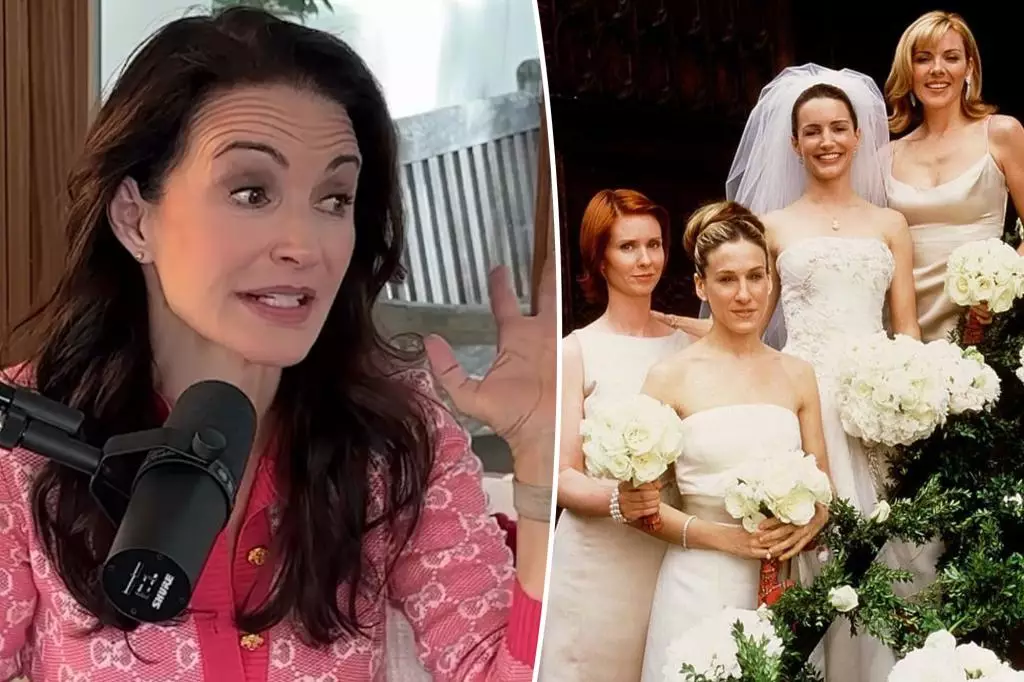The beloved television series “Sex and the City” is remembered not only for its iconic characters and sharp wit but also for its self-expression through fashion. However, like many productions, the process wasn’t without its moments of tension, particularly regarding wardrobe choices. Kristin Davis, who portrayed the bubbly and romantic Charlotte York, recently opened up about a lingering dispute involving her co-star Sarah Jessica Parker—who plays the show’s female lead Carrie Bradshaw—centered around a bridesmaid dress from Charlotte’s wedding episode.
Davis divulged that Parker has reportedly held onto her dissatisfaction regarding the beige bridesmaid dress from Season 3, suggesting that this wardrobe faux pas may still irk her fellow actress. The discussion emerged during a podcast with showrunner Michael Patrick King, where Davis recounted the memorable but rather contentious filming of the wedding scene between Charlotte and her on-screen husband, Trey MacDougal. The disagreement highlighted how even the most glamorous settings can become battlegrounds over personal expression, reinforcing that fashion can be as emotional as it is technical.
The irony of Parker’s wardrobe conflict is that the bridesmaid dresses, created by renowned designer Vera Wang, were thoughtfully selected to complement the theme of the wedding. However, Parker’s discontent with the beige color was so intense that she reportedly took it upon herself to alter the dress, adding tartan elements to align with the traditional Scottish motif of her co-star’s character’s husband. This rebellious act sheds light on the deep emotional links characters form with their costumes. For Parker, perhaps the dress was a representation of who Carrie Bradshaw was versus who she wanted to be at that moment—an internal struggle exacerbated by the pressures of appearing perfect, adorned in a way that complements the wedding’s central figure, Charlotte.
While dress shape and hue carry their own significance in any narrative, they also allow characters to project facets of their personality. Davis humorously interjected during the podcast that Parker’s extreme reaction—to completely cut up a high-end garment—showcases the peculiar dynamics of dressing for a role. This reveals deeper issues of character alignment and personal stake in their roles, as each actress likely desires to create a lasting impact on viewers through their aesthetic representation.
The wardrobe clash showcased an intriguing interplay between personal sentiment and professional obligation—a common occurrence in the world of television production, especially in series that place significant emphasis on style. As presented in Davis’s discussion, every character had their unique take on bridesmaids’ fashion, creating an intentional but competitive landscape amid creative differences. This dynamic can lead to instances of miscommunication and misunderstanding when working collaboratively, especially on a show where each character’s wardrobe must complement one another logically and narratively.
In more extensive terms, fashion plays an essential role in the cultural narrative constructed by series like “Sex and the City.” The show established a framework through which viewers could engage with complex emotional landscapes while simultaneously indulging in aspirational living. As the characters navigated their lives in the bustling city, their wardrobes served as symbols of empowerment, identity, and social status—all themes resonant in contemporary audiences’ lives.
While both Parker and Davis have moved onto various projects, the legacy of their characters and the stylistic statements made through their costumes remain entrenched in pop culture. As Davis reflects on their experiences on-set, it brings forth a sense of nostalgia but also of the evolution of fashion in character-based narratives, and how they can transcend their on-screen purpose to speak to viewers on a larger societal level.
Ultimately, the wardrobe debacle surrounding a seemingly innocuous bridesmaid dress serves as a reminder that even in the realms of make-believe, the complexities of identity, beauty, and that ever-elusive quest for perfection often bleed into the colors of fabric. In the world of “Sex and the City,” the blend of friendship and rivalry harmonizes spectacularly—as does the evolving aesthetic of the show that continues to inspire without overshadowing its cast’s personal journeys.

